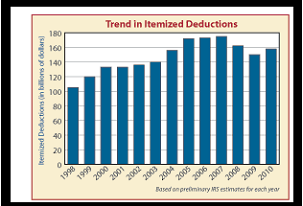Those who work with donors considering the most effective ways to make charitable gifts have an interesting few months ahead of them.
Uncertainty about the economy’s health, consumer confidence and the future of income and estate taxes continues to make efficient philanthropic planning both challenging and potentially rewarding.
Giving on the rise
 IRS estimates of the total amount of itemized gifts to charity in 2010 rose by 6 percent over 2009 figures, from $148 billion to $158 billion. The chart shows the amount of itemized deductible gifts from 1998 until 2010.
IRS estimates of the total amount of itemized gifts to charity in 2010 rose by 6 percent over 2009 figures, from $148 billion to $158 billion. The chart shows the amount of itemized deductible gifts from 1998 until 2010.
If this rate of increase continued in 2011 and this year, itemized deductions should return to an estimated level of more than $175 billion, the previous high point in giving before the Great Recession.
The downward trend in giving caused by the recession, financial crisis and resulting stock market crash appears to have ended in 2010 as the economy began emerging from the depths of the recession, and many high-net-worth individuals may once again have the necessary confidence to make larger gifts.
Inaction means action
There’s no way to know what the federal tax structure will look like even a year from now, but there are areas of certainty you can depend on in the coming months.
- Unless Congress acts before the end of the year, two automatic changes will occur on Jan. 1, 2013:
- The Bush tax cuts of 2001 will expire, changing income, estate and gift tax rates.
The gift and estate tax credit amount of $5.12 million will return to $1 million.
Although these two possibilities may not happen, the possibility of Congressional gridlock leading to inaction and a change in the tax structure occurring by default is very real, especially this election year.
A look at some possibilities
Debate and discussion about the future of the soon-to-expire Bush-era tax cuts, the charitable income tax deduction, the Jan. 1 return of the Pease Amendment and even the implementation of some version of a “Buffett Rule” offer several scenarios—all of which are likely to affect charitable giving:
- Limiting the charitable income tax deduction to the 28 percent tax bracket with existing tax rates
- Limiting the charitable income tax deduction to the 28 percent tax bracket and repealing the Bush tax cuts
- Instituting the Buffett Rule (those with income above $1 million would pay a flat rate of 30 percent)
- Return of the Pease Amendment, which requires a reduction in charitable and other itemized deductions by 3 percent of income above a certain threshold
If the Buffett Rule or something similar becomes part of the tax code, it is likely the charitable deduction will be the only income adjustment allowed at the $1 million and up level. The recently defeated version of the Buffett Rule allowed charitable deductions as the only adjustment to income, and many observers believe the charitable deduction will remain in any future version. This could mean that charitable tax planning will take on renewed importance for very high-income individuals.
There is some certainty
The current degree of uncertainty in the federal tax code does not mean estate planning and planned giving should or will cease until Congress takes action. There are many attractive options available now to those with charitable intentions.
The IRS recently reported that charitable lead trusts (CLTs) have been the fastest-growing type of charitable trust over the past several years. (See Page 1 of last month’s Give & Take.) They now provide more dollars each year for charitable use than charitable remainder trusts or pooled income funds. CLTs are likely to continue to be a popular way to leverage the $5.12 million exemption while it is still in place.
Although tax considerations are rarely the primary motivator for charitable gifts, many are predicting that any after-tax increase in the “cost” of making such gifts through proposed limitations in deduction amounts will result in a drop in charitable gifts by those affected.
More income will be required to give the same amount and gifts will need to be reduced unless donors make corresponding reductions in spending, saving or giving to loved ones. For this reason it is important to emphasize to donors with large outstanding commitments the importance of giving all they can this year while the tax benefits remain fully intact.
Recovery of securities gifts
The Great Recession brought about a fall in stock market values and a related decline in gifts of securities. With the Dow Jones Industrial Average back up to the 13,000 range, gifts of stocks and other appreciated properties hold renewed attraction.
Many investors with large gains as the market has recovered may wish to take advantage of the opportunity to give appreciated securities, then use cash to repurchase them, increasing their cost basis to current market levels. The remainder of this year may see gifts of appreciated securities at levels not seen since 2007.
In short
There are many opportunities during the remainder of this year for those who wish to make charitable gifts with multiple benefits. As we have seen, charitable lead trusts and gifts of cash and appreciated securities may become particularly appealing options in the months to come as donors learn to seize the opportunities that are available to them between now and the end of 2012.

